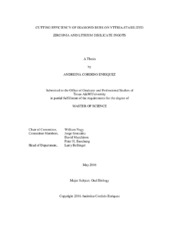| dc.contributor.advisor | Nagy, William W | |
| dc.creator | Cordido Enriquez, Andreina | |
| dc.date.accessioned | 2016-07-08T15:09:53Z | |
| dc.date.available | 2018-05-01T05:48:46Z | |
| dc.date.created | 2016-05 | |
| dc.date.issued | 2016-02-24 | |
| dc.date.submitted | May 2016 | |
| dc.identifier.uri | https://hdl.handle.net/1969.1/156885 | |
| dc.description.abstract | The purpose of this in vitro study was to assess the cutting efficiency of diamond burs on Y-TZP Zirconia as measured by heat generation during cutting; time needed to cut 4 mm of an ingot shaped specimen; and material lost after cutting compared to a Lithium Disilicate control. Forty six cuts of each material were made in a custom test device that held the handpiece in a fixed position and moved the sample toward the cutting bur. Measurement of time, temperature change and weight loss were made to describe the cutting efficiency of a diamond bur.
The amount of time needed to cut Zirconia was almost three times longer than the time needed to cut Lithium Disilicate and was found statistically significant (P < 0.001) in an Independent Sample Test.
The temperature decreased during the cut, but this change was not significant, suggesting that using water coolant would control temperature change.
A Pearson Correlation test demonstrated the duration of the cut was related to both temperature and change of temperature for Zirconia but not for Lithium Disilicate, suggesting that the longer the cut for Zirconia the lower the temperature and the larger the change in temperature.
There was a significant difference (P < 0.001) for material loss for each group and also in the comparison of material loss between the two groups, Zirconia losing double of the weight than Lithium lost. This should be described as a proportional loss, as Zirconia is heavier than Lithium Disilicate, therefore the weight of material loss for Zirconia is greater than for Lithium Disilicate
Within the limitations of this study it can be concluded that the amount of time needed to cut Zirconia was almost three times longer than the time needed to cut Lithium Disilicate. There was no significant heat generation when water spray was used. The material loss for Zirconia was double that for Lithium Disilicate. | en |
| dc.format.mimetype | application/pdf | |
| dc.language.iso | en | |
| dc.subject | Cutting efficiency | en |
| dc.subject | heat generation | en |
| dc.subject | Y-TZP Zirconia | en |
| dc.subject | ingot | en |
| dc.title | Cutting Efficiency of Diamond Burs on Yttria-Stabilized Zirconia and Lithium Disilicate Ingots | en |
| dc.type | Thesis | en |
| thesis.degree.department | College of Dentistry | en |
| thesis.degree.discipline | Oral Biology | en |
| thesis.degree.grantor | Texas A & M University | en |
| thesis.degree.name | Master of Science | en |
| thesis.degree.level | Masters | en |
| dc.contributor.committeeMember | Gonzalez, Jorge | |
| dc.contributor.committeeMember | Murchison, David | |
| dc.contributor.committeeMember | Buschang, Peter H | |
| dc.type.material | text | en |
| dc.date.updated | 2016-07-08T15:09:53Z | |
| local.embargo.terms | 2018-05-01 | |
| local.etdauthor.orcid | 0000-0002-0690-3249 | |


